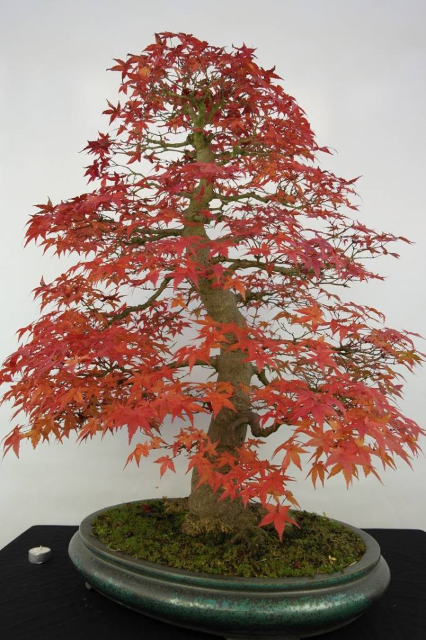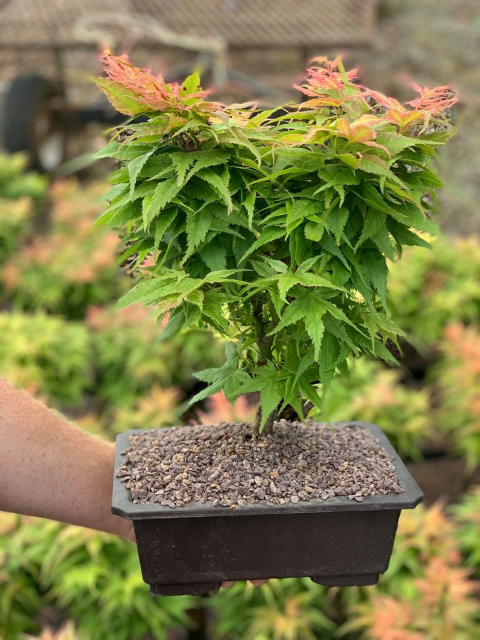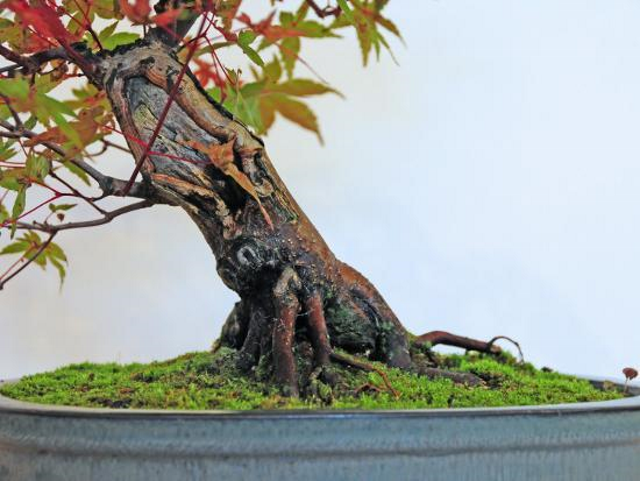The Japanese Maple (Acer palmatum) is certainly one of the most beautiful trees to cultivate as Bonsai
The Japanese Maple (Acer palmatum) is certainly one of the most beautiful trees to cultivate as Bonsai . The five-pointed leaves, which change color depending on the season, give this plant a charm and elegance that is difficult to find in other essences.
The existing species are hundreds, with notable variations of shape, size and color but, wanting to describe only those normally found on the market, we can divide the Maple palmates in three categories: Acer palmatum, Acer palm. rubrum, Acer palm.
It is the strongest and most vigorous species; the five-pointed leaves, read and of an intense color, turn red in autumn, before falling, and give the Bonsai a truly fascinating appearance.
Red Maple: the peculiar characteristic of this plant consists in the coloring of the leaves, which appear red from when they spring, in the spring, until they fall, in autumn.
It is the most valuable species: the leaves, smaller and lighter than the other Maples, have a beautiful crimson red color when they appear, then they turn green in summer, to become red in the autumn before breaking away from the branch.

EXPOSURE.
In spring, a period in which the new leaves sprout, it is convenient to keep the Maples in full sun: adequate lighting allows the bonsai to vegetate vigorously, producing sturdy branches and especially small leaves with an intense color.
In summer, on the other hand, the Maples should be placed in the shade , otherwise the very delicate leaves would curl up under the rays of the sun. In addition to protecting them from the heat, to recreate the humidity conditions necessary for this plant, it can be placed in a saucer filled with gravel kept moist.
In autumn, it can be regulated as in spring, unless we are in the presence of a particularly hot season; in this case it is better to keep the shady bonsai, until the sun has attenuated its intensity.
In winter, in the southern regions you can keep the maple trees outdoors, in full sun; while in the northern regions, it is advisable to protect them from frost by placing them in a cold greenhouse, or at least under a roof.
WATERING.
The palmato maple loves fresh and moist soils, therefore, care must be taken not to let the substratum dry too , especially in summer, to avoid the "dry blows" that can cause the death of the Bonsai, therefore, by using a watering can with a thin-hole shower head, the soil must be abundantly watered when it begins to dry.

Also in summer, it is very useful to spray the leaves daily; this operation, necessary to reproduce the natural habitat of Maple, is also useful to avoid the summer infestations of Red Spider.
PRUNING.
The best time for pruning the Maples is winter : in this season, in fact, the bonsai is without leaves and you can clearly see the structure of the plant, moreover, the vegetative stasis avoids dangerous losses of sap from the cuts made. Especially if the bonsai is repotted, it is advisable to make an adequate pruning that compensates for the shortening of the roots.
The choice of the branches to be shortened or to be eliminated depends on the style of the Bonsai, in any case those branches that develop vertically, those that cross and must be eliminated, having the Maple buds in pairs, the opposite branches must be removed.
The branches larger than 1/2 centimeter must be cut with the concave truncated cutters and the cuts must be medicated with the healing paste, for the smaller branches the long shears are used and it is not essential to dress the cuts.
STAPLE.
To obtain a more balanced growth, in the spring the new shoots are "pinched"; the operation is carried out with the long scissors, shortening the branches that have just appeared, after the first or second internode .
DEFOLIATION.
In May-June defoliation can be carried out, a technique useful for reducing the size of the leaves. The operation is carried out with the appropriate defoliator, eliminating all the leaves of the Bonsai , leaving only the petiole attached to the branch. After a few days, the plant produces new leaflets, smaller than the previous ones, which make the bonsai proportionate and harmonious. Defoliation is a technique that requires a lot of energy, therefore, remember to do it only on plants in a perfect state of health , since a suffering bonsai may not be able to regain vegetation.
POTTING.
As for pruning, the best period for repotting goes from the fall of the leaves (November) to the swelling of the buds (March) before the new leaves snack. The root system must be reduced by 1/3 and, if necessary, it can be completely freed from the old soil, working "bare-rooted".
The substrate must have a good drainage, but it must not dry too quickly, therefore, it is not appropriate to use Akadama absolute, but a soil containing organic substance (such as Ready Soil). Remember to repot only healthy plants and, if the winter is particularly harsh, protect the newly repotted maple trees from the frost.
FERTILIZER.
The Maple is a particularly "voracious" plant, therefore, the fertilizations must be constant throughout the vegetative period (March-June and mid-August-mid-October). Being also a sensitive plant, be careful not to overdo the doses and preferably use a slow release fertilizer.
WINDING.
Spring, when the sap flows in the branches, is the best time to educate the branches with the application of coppery aluminum wire. In February you can start applying it on the branches to be modeled; the thickness of the wire must be adequate to the size and flexibility of the branch, therefore, it is convenient to have different measures.

Remember to wrap the wire at an angle of 45 ° (if the coils are too close together, the wire does not hold) starting by wrapping the thickest branches and reaching the thinnest. If the thread applied cannot hold the branch in position, another thread can be applied, the important thing is not to cross them.
DEFENSE FROM PARASITES.
The pathologies to which the Maple can go are: Aphids , in spring; Red Spider , in summer; Oidium (white mal) in autumn.
An effective defense is represented by preventive fortnightly treatments , with a insecticide-acaricide, against Aphids and Red Spider, followed by an anticryptogamic, against Oidium.